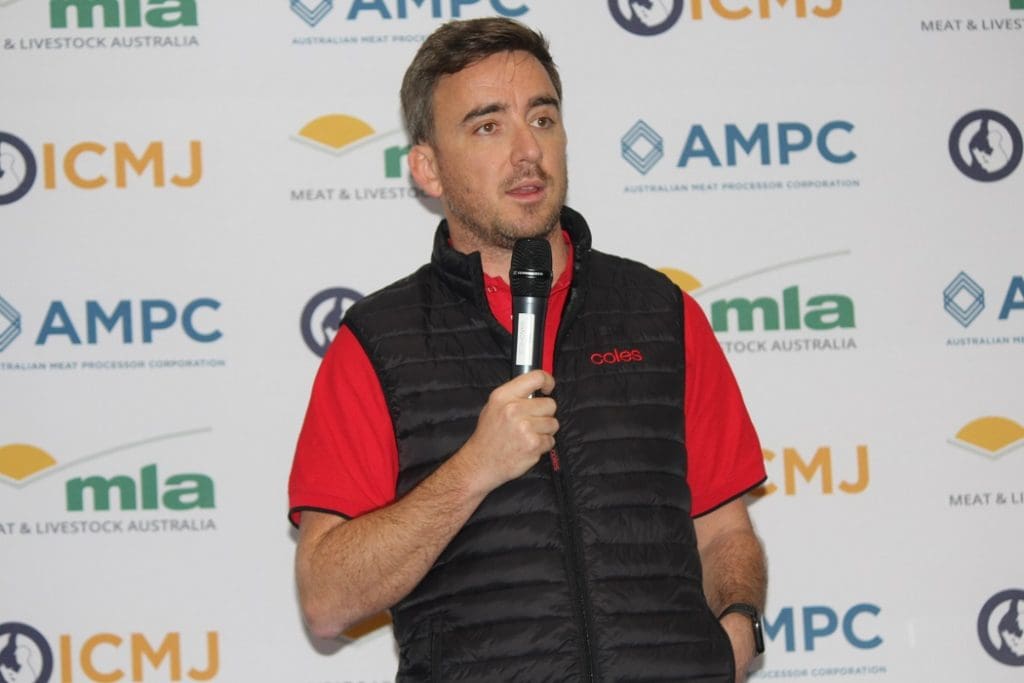
General manager of Coles’ meat, deli and seafood business unit, Martin Smithson.
IN the age of artificial intelligence, young people entering the red meat industry will need to have strong interpersonal and data leveraging skills, agricultural students were told at last week’s 2023 Intercollegiate Meat Judging Association conference and competition.
In his presentation at the Wagga Wagga Charles Sturt University campus, general manager of Coles’ meat, deli and seafood business unit, Martin Smithson, outlined the use of technology and artificial intelligence in product traceability, store range optimization and monitoring.
Mr Smithson said Coles ran an integrated meat business sourcing three million cattle, lambs and pigs from 2500 farmers and processing 235 million kilograms of product through 12 primary processing facilities.
“So it’s a very unique perspective that we can offer.”
Mr Smithson said the skills young people will need include an ability to have networks, build stakeholder relationships and leverage personal skills.
“Some of the skills that might have been a differentiator ten years ago won’t be a differentiator.”
He said Coles used the business analytic tool PAL BI to generate reports, so he would be also be looking for skills that could leverage data heavily, extrapolate data and develop a spreadsheet.
“The skills that will differentiate you are the skills that AI is never going to replace – which is absolutely to work with stakeholders, build relationships to engage effectively, communicate clearly.”
When asked if there is any scope to use AI to assist customers to select the products they want, Mr Smithson said customers will eventually be getting push notifications on their mobile phones while they are shopping. He gave the example of a customer in a store who had previously bought scotch fillet being notified that the cut was on special.
Mr Smithson said the technology Coles used included electronic National Vendor Declarations (eNVD) for traceability from farms to abattoir to allow effective and stable data use and feedback to farmers of grading, eating quality and yield to then relate this to farm practices and to sustainability.
Eighteen months into his job, Mr Smithson said the Australian red meat industry isn’t tech-shy and wanted to engage in data capture.
Mr Smithson said Coles used data to optimize carcase revenue and in automated carcase ‘balancing’ using algorithms to optimize production of meat cuts that maximize returns to get “the right primal in the right location at the right time for our customers.”
“This is a real gamechanger for us.
“We’ve just launched it in beef, lamb is the next cab off the rank – it’s just a major enabler.”
He said camera technology can be used in processing to improve training, tracking how people work as well as safety and compliance. And when linked to an eNVD, cameras can track a carcase and trace primals “all the way back to the farm,” allowing Coles to prove its carbon and grass-fed claims to build trust, Mr Smithson said.
He said COVID has made QR codes omnipresent and he sees a day when a customer “in the not too distant future“ will be able to scan a cut’s QR code and be able to see the farm an animal came from and when it was processed … or even who processed it and their star sign.
“Our problem is how do we use that data in a way that creates value for the customer.”
Store specific product ranging is a big opportunity
Mr Smithson said the annual turnover in his team is $6 billion and the use of data for store specific ranging of product to suit customers’ profiles is one of the group’s “biggest opportunities” to optimize distribution. He said ranging involved the use of algorithms to match products to customers at the store level.
While declaring that Coles is not capturing any images of customers in stores, machine monitoring is being piloted in Coles delis to allow management of labour gaps by notifying staff when a customer is waiting at a counter. Competitor Woolworths is also using
“This again is step-changing the efficiency of how we operate by using very effective deployment of data.”
Mr Smithson concluded his presentation with a closing statement created with the artificial intelligence chatbot ChatGPT.
“In conclusion, ladies and gentleman, the power of data and artificial intelligence is transforming the landscape of the meat industry, revolutionizing the way that we produce, process and distribute meat products.
By embracing these technological advancements we have the opportunity to enhance efficiency, improve sustainability and deliver high quality products to meet ever-evolving demands of our customers.
“However, let us not forget that behind these innovations lies the heart and soul of our industry; the hard-working farmers, producers and workers who dedicate their lives in nourishing the world.
As we move forward, let us strive for harmonious integration of data-driven insights and human expertise creating a future where technology complements and powers our industry’s finest traditions.
Together we can shape a prosperous and sustainable future for the meat industry where the power of data and artificial intelligence truly transforms the way we bring nourishment to the world’s table.”
“All hail your robot masters … they didn’t say that,” Mr Smithson said.

HAVE YOUR SAY